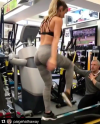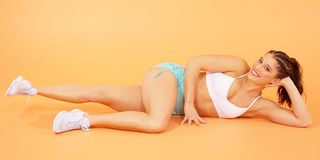Slacklining Is the Hottest Way to Lift Your Booty
You bet it works.
But another prop therein has Gunnar’s clients working their butts off: It’s called a slackline fitness stand, a device that supports a band known as a slackline.
Although Gunnar has been using this device to torture train clients for about two years, client and fitness model Paige Hathaway Instagrammed a video of herself using it during a recent training session:
Slacklines look like tight ropes, except they tend to be several inches wide and, you guessed it, have more slack. These conditions promote a bit of bounce that makes moves look super dynamic and fun, one reason why climbers began to tie these bad boys between sturdy trees to mess around. Many people still do:
Nowadays, fit, fearless humans known as “trickliners” tie extra-long slacklines to sturdy posts and do all sorts of bouncing, yoga poses, and flips.
While these moves are Very Impressive, simply standing on a slackline is a feat on its own, since the surface is less sturdy than solid ground (and gravity is unrelenting). It’s why short, low slacklines are being used in gym settings to amp up the intensity of many exercises. Something so simple as planking on a slackline can make the move even more effective, since the prop’s instability calls for extra effort to maintain alignment and balance. “Challenging stability at that level creates new and different muscle firing patterns that force the body to adapt and improve,” Gunnar says.
In his studio, he has clients (like Paige, below) place one foot on the slackline to perform moves like a decline reverse-lunge with a knee raise. “We weave it into workouts so they don’t have time to love or hate it,” Gunnar says.
Watch closely and you’ll see Paige sort of struggling. (Those leg tremors? #BeenThere.) In her post, she cites some of the modality’s benefits, which include improvements in balance and strength in the core and lower body — I see you, 🍑! Of course, the body parts that benefit from this particular prop depend on which exercises you do: Push-ups, triceps dips, and plank holds performed with your hands on the slackline can target your chest, triceps, shoulders, and abs. Or you can plop your butt down on the slackline, lift your feet, and lean back, then bring your arms and legs together in a V-up that will make your core cry. To boost your booty, try squats, lunges, step-ups, and hip thrusters performed with your feet on the band — all of which will give your glutes a real run for their money. That said, Gunnar warns newbies to start slow, using a human or nearby wall for balance. And it won’t hurt to place padding on either side of the slackline just in case you go down.
If your gym isn’t equipped for slacklining (try this Portable Slackline Fitness Stand and Slackline), and you can’t even with the whole double-tree-trunk set-up, all hope isn’t lost. Placing your hands or feet on the flat side of a wobbly BOSU can also mess with your stability enough to deliver similar results. Just be careful — gravity’s a bitch!







